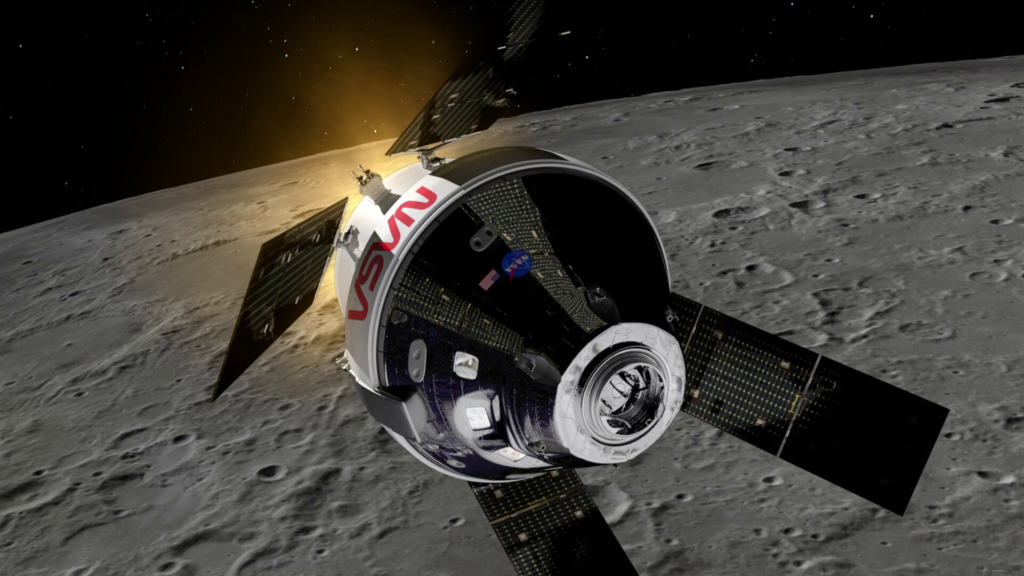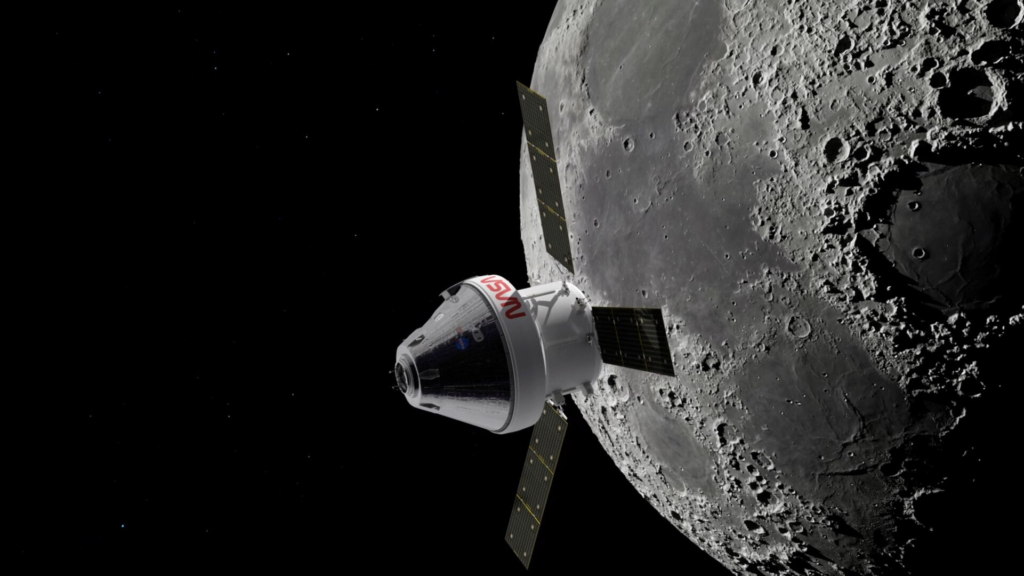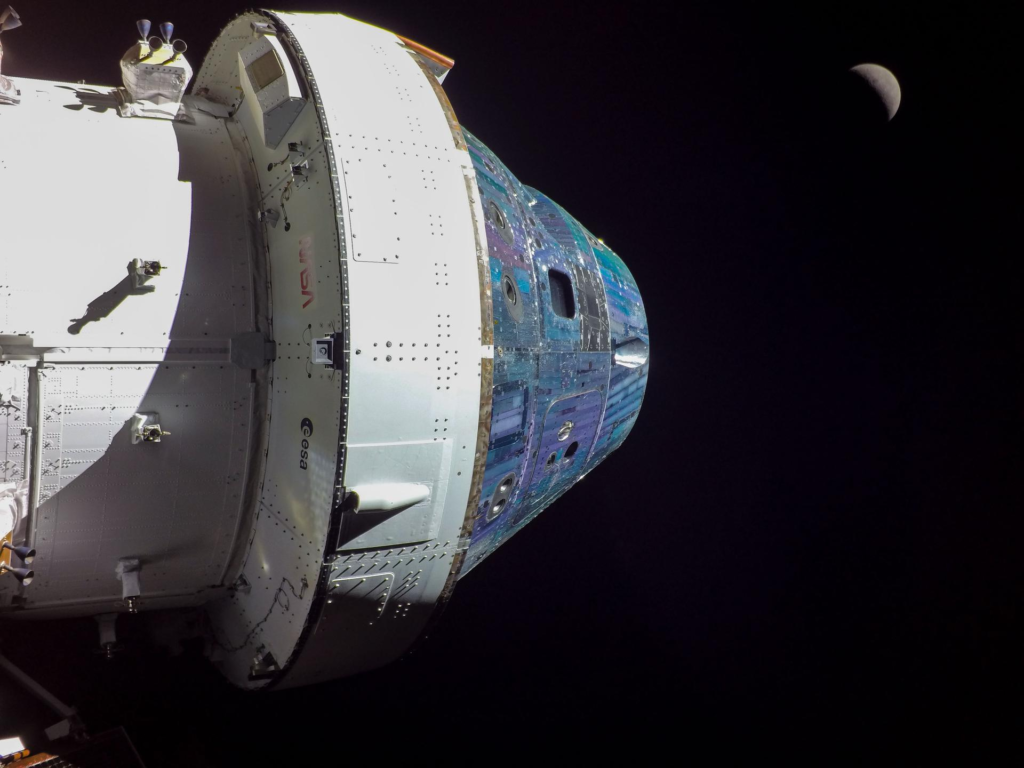
NASA’s Orion Spacecraft Continues To Make Progress On Its Moon Journey
It has officially been 9 days since the Space Launch System lifted off with the Orion Capsule on top. Since then, the spacecraft has not only made it to the Moon, but is set to complete a few different important mission milestones very soon. Not to mention some of the final necessary tests including its upcoming reentry and splashdown scheduled in early December.
Just yesterday Orion completed its sixth outbound trajectory correction burn. Leading up to today’s long awaited distant retrograde insertion burn. The orbit is “distant” in the sense that it’s at a high altitude from the surface of the Moon, and it’s “retrograde” because Orion will travel around the Moon opposite the direction the Moon travels around Earth. This is one of the first steps in Orion’s long journey back toward Earth.
While there were some initial complications, NASA has found solutions and the mission is continuing on. If the rest of the mission is successful, the next step apart of Artemis will be launching the first humans ever on SLS and within Orion. Here I will go more in-depth into the progress that has been made in the last couple of days, Orion’s important insertion today, what to expect in the future, and more.
Orion Update

Just two days ago on the 23rd, NASA tweeted saying, “@NASA_Orion continues to travel away from the Moon as it prepares to enter a distant retrograde orbit. Orion will reach its farthest distance from the Moon on Nov. 25, just before performing the next major burn to enter the orbit.” Specifically, on the eighth day of its mission, Orion continued to travel farther away from the Moon as it prepares to enter a distant retrograde orbit. The orbit is “distant” in the sense that it’s at a high altitude from the surface of the Moon, and it’s “retrograde” because Orion will travel around the Moon opposite the direction the Moon travels around Earth.
Orion exited the gravitational sphere of influence of the Moon Tuesday, Nov. 22, at 9:49 p.m. CST at a lunar altitude of 39,993 miles. NASA’s Mission Control Center at the agency’s Johnson Space Center in Houston unexpectedly lost data to and from the spacecraft at 12:09 a.m. for 47 minutes while reconfiguring the communication link between Orion and Deep Space Network. Teams have resolved the issue, and the spacecraft remains in a healthy configuration while engineers analyze data to determine the cause. In addition, While in transit to the distant retrograde orbit, engineers conducted the first part of the propellant tank slosh development flight test, called prop slosh, which is scheduled during less active parts of the mission. The test calls for flight controllers to fire the reaction control system thrusters when propellant tanks are filled to different levels. Engineers measure the effect the propellant sloshing has on spacecraft trajectory and orientation as Orion moves through space. The test is performed after the outbound flyby burn and again after the return flyby burn to compare data at points in the mission with different levels of propellant onboard.
Just yesterday NASA tweeted again mentioning, “On the ninth day of the #Artemis I mission, the @NASA_Orion spacecraft completed its sixth outbound trajectory correction burn at 4:52pm ET (21:52 UTC). This is the final trajectory correction before entering distant retrograde orbit tomorrow.” In this case, during the last day in the transit to distant retrograde orbit, flight controllers performed a third in a series of planned star tracker development flight tests relative to the Sun, with a fourth planned for tomorrow. Star trackers are a navigation tool that measure the positions of stars to help the spacecraft determine its orientation. In the first three flight days, engineers evaluated initial data to understand star tracker readings correlated to thruster firings.
The spacecraft completed its sixth outbound trajectory correction burn at 3:52 p.m. CST, firing the European Service Module’s auxiliary engines for 17 seconds to propel the spacecraft at 8.9 feet per second. This is the final trajectory correction before entering distant retrograde orbit. When in lunar orbit, Orion will perform three orbital maintenance burns to keep the spacecraft on course. Last night, engineers began a 24-hour test of the reaction control system engines to evaluate engine performance for standard and non-standard thruster configurations. This test will provide data to inform procedures and ensure that the reaction control thrusters can control Orion’s orientation in an alternate configuration if there is an issue with the primary configuration. Just after 1:42 p.m. CST on Nov. 24, Orion was traveling 222,993 miles from Earth and 55,819 miles from the Moon, cruising at 2,610 miles per hour. All of which leads up to today’s retrograde burn.
Distant Retrograde & Future

Now that we know more about what Orion has been doing in the last couple of days, we can take a closer look at the significance of today’s distant retrograde insertion and more. Distant retrograde orbit or DRO provides a highly stable orbit where little fuel is required to stay for an extended trip in deep space to put Orion’s systems to the test in an environment far from Earth. “Artemis I is a true stress test of the Orion spacecraft in the deep space environment,” said Mike Sarafin, Artemis Mission Manager. “Without crew aboard the first mission, DRO allows Orion to spend more time in deep space for a rigorous mission to ensure spacecraft systems, like guidance, navigation, communication, power, thermal control, and others are ready to keep astronauts safe on future crewed missions.”
The orbit is “distant” in the sense that it’s at a high altitude from the surface of the Moon, and it’s “retrograde” because Orion will travel around the Moon opposite the direction the Moon travels around Earth. Orion will travel about 240,000 miles from Earth to the Moon, then about 40,000 miles beyond the Moon at its farthest point while flying in DRO. DRO is highly stable because of its interactions with two points of the planet-moon system where objects tend to stay put, balanced between the gravitational pull of two large masses – in this case, the Earth and Moon – which allows a spacecraft to reduce fuel consumption and remain in position while traveling around the Moon.
After the spacecraft gets its big push toward the Moon from the SLS rocket’s upper stage engine, Orion’s service module, built by ESA (European Space Agency), will provide the propulsion to get to DRO. Using the DRO for Artemis I requires the use of four major targeting navigational burns – two close and two far away from the Moon – to enter and exit the orbit. Orion will fly to its closest lunar approach about 60 miles above the surface of the Moon, then rely on the Moon’s gravitational force together with a propulsive burn – known as the outbound powered flyby – to direct the spacecraft toward DRO where Orion performs a second propulsive burn to enter DRO and stabilize in the orbit.
“NASA’s knowledge of DRO evolved out of many prior human spaceflight architecture studies,” said Merancy. “As a result of studies for ARM, NASA’s mission planners developed a strong knowledge base of the orbit and determined DRO could meet the objectives for Artemis I, so mission planners opted to capitalize on the studies and knowledge of it as a mission destination.”For its return trip to Earth, Orion will perform a departure burn from DRO to direct itself to another close flyby within about 60 miles of the Moon’s surface. Another engine burn by the service module, known as the return powered flyby burn, and gravity assist from the Moon itself will slingshot Orion on a trajectory back home where the Earth will accelerate Orion to a speed of about 25,000 mph. This incredible speed will produce temperatures of approximately 5,000 degrees Fahrenheit – or about half the surface of the Sun – on the crew module during atmospheric entry, providing an opportunity to demonstrate Orion’s heat shield and parachute-assisted splashdown in the Pacific Ocean.
Specifically, after about four to six weeks and a total distance traveled exceeding 1.3 million miles, the mission will end with a test of Orion’s capability to return safely to the Earth as the spacecraft makes a precision landing within eyesight of the recovery ship off the coast of Baja, California. Following splashdown, Orion will remain powered for a period of time as divers from the U.S. Navy and operations teams from NASA’s Exploration Ground Systems approach in small boats from the waiting recovery ship. The divers will briefly inspect the spacecraft for hazards and hook up tending and tow lines, and then engineers will tow the capsule into the well-deck of the recovery ship to bring the spacecraft home.
Conclusion
The Orion spacecraft has been very busy for over a week now. The last couple of days have included some important tests and a lot of preparation for today’s maneuver. If successful, Orion will be placed in a deep retrograde orbit and not long after, return home with a planned splashdown on December 11th. We will have to wait and see how it progresses and the impact it has on the space industry.
